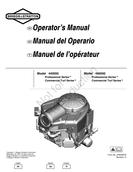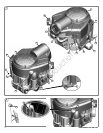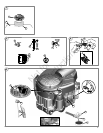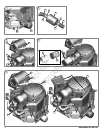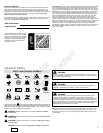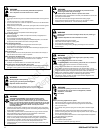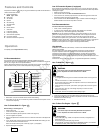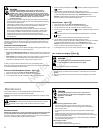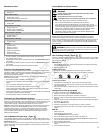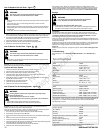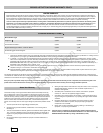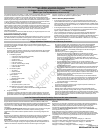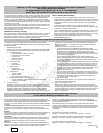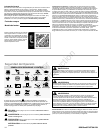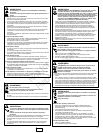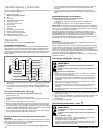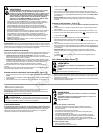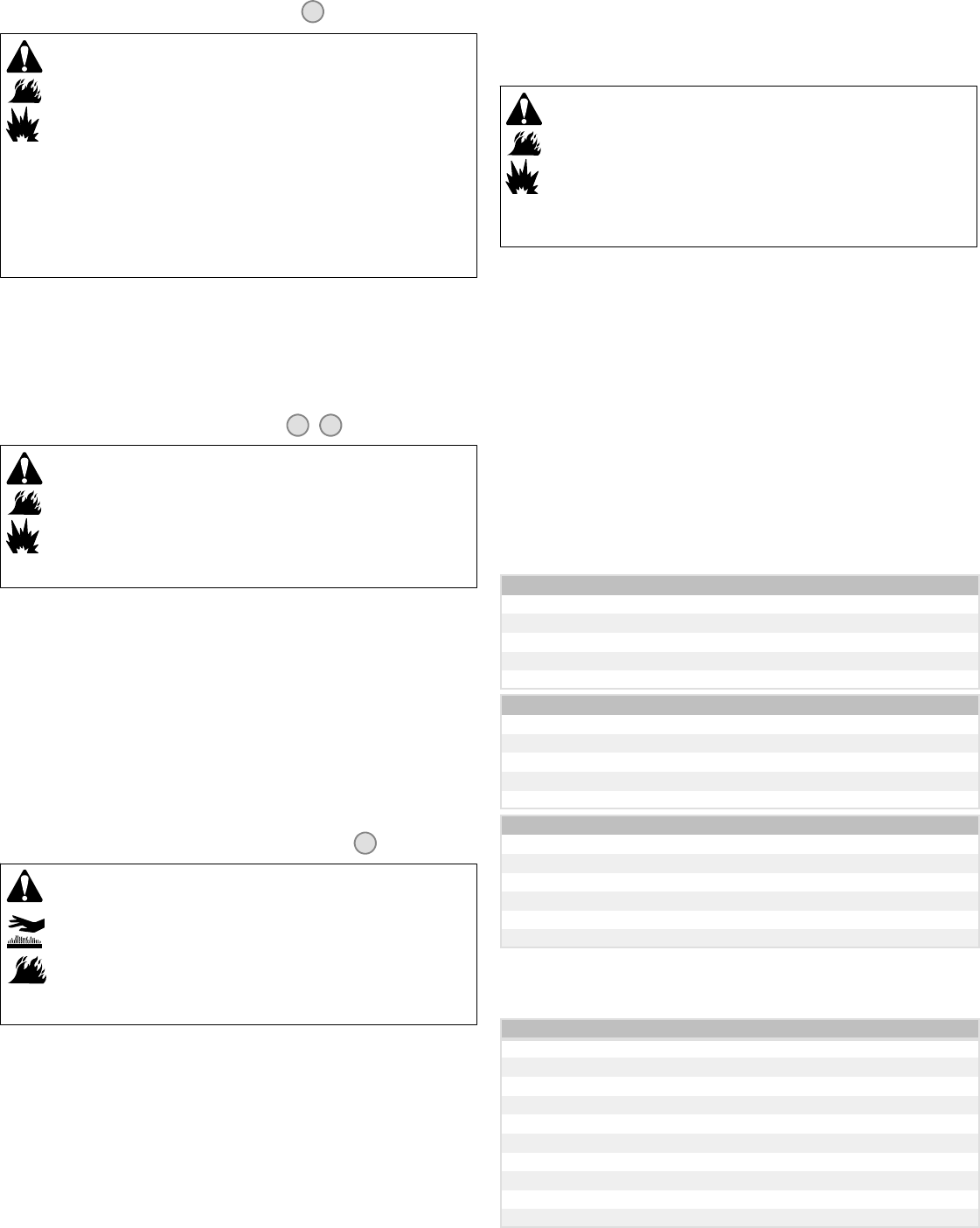
10
BRIGGSandSTRATTON.COM
How To Replace The Fuel Filter - Figure
8
WARNING
Fuel and its vapors are extremely flammable and explosive.
Fire or explosion can cause severe burns or death.
Keepfuel awayfromsparks, openflames,pilot lights,heat,and otherignition
sources.
Check fuellines, tank, cap, andfittings frequently forcracks or leaks.
Replace ifnecessary.
Before replacing the fuel filter, drain the fuel tank orclose the fuel shut-off valve.
Replacement parts must be the same and installed in the same position as the
original parts.
If fuel spills, wait until it evaporates before starting engine.
1. Before replacing the fuel filter (A, Figure 8), if equipped, drain the fuel tank or close
the fuel shut-off valve. Otherwise, fuel can leak out and cause afire or explosion.
2. Use pliers to squeeze tabs (B) on the clamps (C), then slide the clamps away from
the fuel filter. Twist and pull the fuel lines (D) off of the fuel filter.
3. Check the fuel lines for cracks or leaks. Replace if necessary.
4. Replace the fuel filter with an original equipment replacement filter.
5. Secure the fuel lines with the clamps as shown.
How To Service The Air Filter - Figure
9 10
WARNING
Fuel and its vapors are extremely flammable and explosive.
Fire or explosion can cause severe burns or death.
Never start or run the engine with the air cleaner assembly (if equipped) or the
air filter (if equipped) removed.
NOTICE: Do not use pressurized air or solvents to clean the filter. Pressurized air can
damage the filter and solvents will dissolve the filter.
Cyclonic Air Filter System
1. Loosen the fasteners (A) and remove the cover (B).SeeFigure9.
2. Open the latch (C) and remove the air filter (D). See Figure 10.
3. Remove the pre-cleaner (E), if equipped, from the filter.
4. To loosen debris, gently tapt he air filter on a hard surface. If the air filter is
excessively dirty, replace with a new air filter.
5. Wash the pre-cleaner in liquid detergent and water. Then allow it to thoroughly air
dry. Do not oil the pre-cleaner.
6. Assemble the dry pre-cleaner to the filter.
7. Install the air filter and close the latch.
8. Install the cover and secure the fasteners.
How To Clean The Air Cooling System - Figure
11
Running engines produce heat. Engine parts, especially muffler,
become extremely hot.
Severe thermal burns can occur on contact.
Combustible debris, such as leaves, grass, brush, etc. can catch fire.
WARNING
Allow muffler, engine cylinder and fins to cool before touching.
Remove accumulated debris from muff ler area and cylinder area.
NOTICE: Do not use water to clean the engine. Water could contaminate the fuel
system. Use a brush or dry cloth to clean the engine.
This is an air cooled engine. Dirt or debris can restrict air flow and cause the engine to
overheat, resulting in poor performance and reduced engine life.
1. Use a brush or dry cloth to remove debris from theair intake area (A).
2. Keep linkage, springs and controls (B) clean.
3. Keep the area around and behind the muffler free of any combustible debris (Figure
11).
4. Make sure the oil cooler fins (C) are free of dirt anddebris.
5. Loosen the fasteners (D) and remove the cover (E).
6. Loosen the fasteners (F) and open the debris accesspanels (G). Remove any grass
and debris that has accumulated on the cylinders.
7. Close the debris access panels and secure with the fasteners.
8. Install the cover and secure with the fasteners.
After a period of time, debris can accumulate under the air intake grille and in the
cylinder cooling fins and cause the engine to overheat. This debris cannot be removed
without partial disassembly of the engine. Have a Briggs & Stratton Authorized Dealer
inspect and clean the air cooling system as recommended in the Maintenance Chart.
Storage
WARNING
Fuel and its vapors are extremely flammable and explosive.
Fire or explosion can cause severe burns or death.
When Storing Fuel Or Equipment With Fuel In Tank
Store away from furnaces, stoves, water heaters or other appliances that have
pilot lights or other ignition sources because they can ignite fuel vapors.
Fuel System
Fuel can become stale when stored over 30 days. Stale fuel causes acid and gum
deposits to form in the fuel system or onessential carburetor parts. To keep fuel fresh,
use Briggs & Stratton Advanced Formula Fuel Treatment & Stabilizer, available
wherever Briggs & Stratton genuine service parts are sold.
There is no need to drain gasoline from the engine if a fuel stabilizer is added according
to instructions.Run the enginefor 2 minutesto circulate thestabilizer throughout the fuel
system before storage.
If gasolinein the enginehas not beentreated witha fuel stabilizer, itmust bedrained into
an approved container. Run the engine until it stops from lack of fuel. The use of a fuel
stabilizer in the storage container is recommended to maintain freshness.
Engine Oil
While the engine is still warm, change the engine oil. See the How To Change The Oil
section.
Troubleshooting
Need Assistance? Go to BRIGGSandSTRATTON.COM or call 1-800-233-3723 (in
USA).
Specifications
Engine Specifications
Model 440000
Displacement 44.18 ci (724 cc)
Bore 3.120 in (79.24 mm)
Stroke 2.890 in (73.41 mm)
Oil Capacity 62 -- 64 oz (1.8 -- 1.9 L)
Engine Specifications
Model 490000
Displacement 49.42 ci (810 cc)
Bore 3.300 in (83.81 mm)
Stroke 2.890 in (73.41 mm)
Oil Capacity 66 -- 68 oz (1.9 -- 2.0 L)
Tune-up Specifications *
Model 440000, 490000
Spark Plug Gap 0.030 in (0.76 mm)
Spark Plug Torque 180 lb-in (20 Nm)
Armature Air Gap 0.008 - 0.012 in (0.20 - 0.30 mm)
Intake Valve Clearance 0.004 - 0.006 in (0.10 - 0.15 mm)
Exhaust Valve Clearance 0.004 - 0.006 in (0.10 - 0.15 mm)
* Engine powerwill decrease 3.5% for each 1,000 feet (300meters) above sea level and
1% for each 10 F(5.6 C) above 77 F(25 C). The engine will operate satisfactorily at
an angle up to 15. Refer to the equipment operator’s manual for safe allowable
operating limits on slopes.
Common Service Parts n
Service Part Part Number
Cyclonic Air Filter 798897
Oil -- SAE 30 100028
Oil Filter 492932
Fuel Filter 691035
Advanced Formula Fuel Treatment & Stabilizer 100117, 100120
Resistor Spark Plug 491055
Long Life Platinum Spark Plug 5066
Spark Plug Wrench 19374
Spark Tester 19368
n We recommend that you see any Briggs & Stratton Authorized Dealer for all
maintenance and service of the engine and engine parts.













